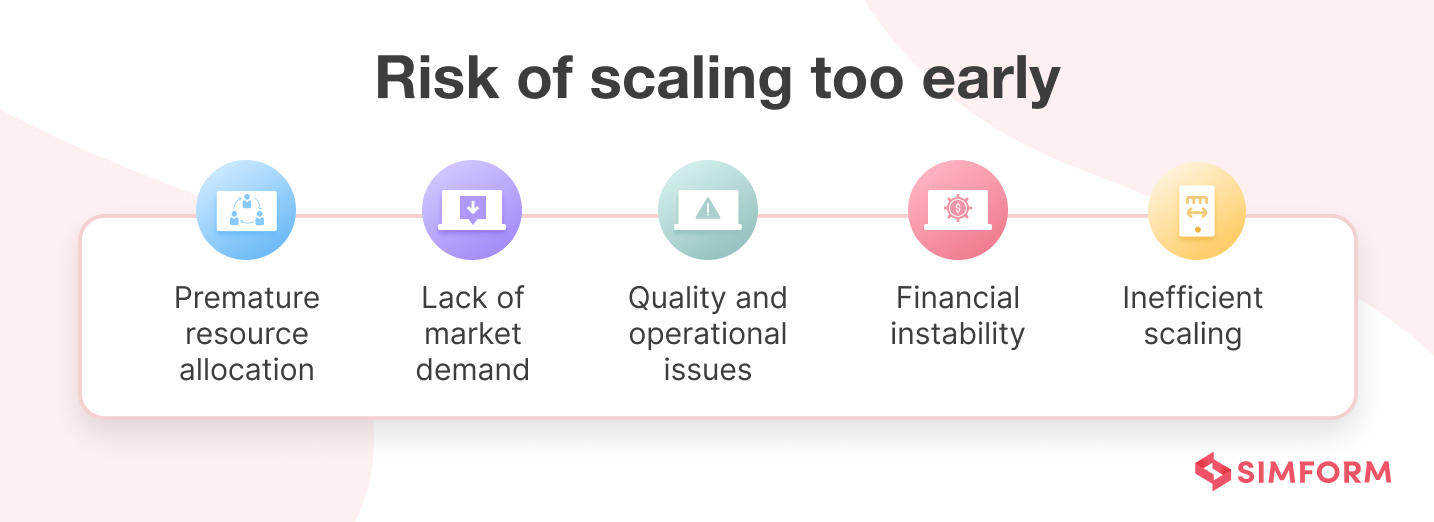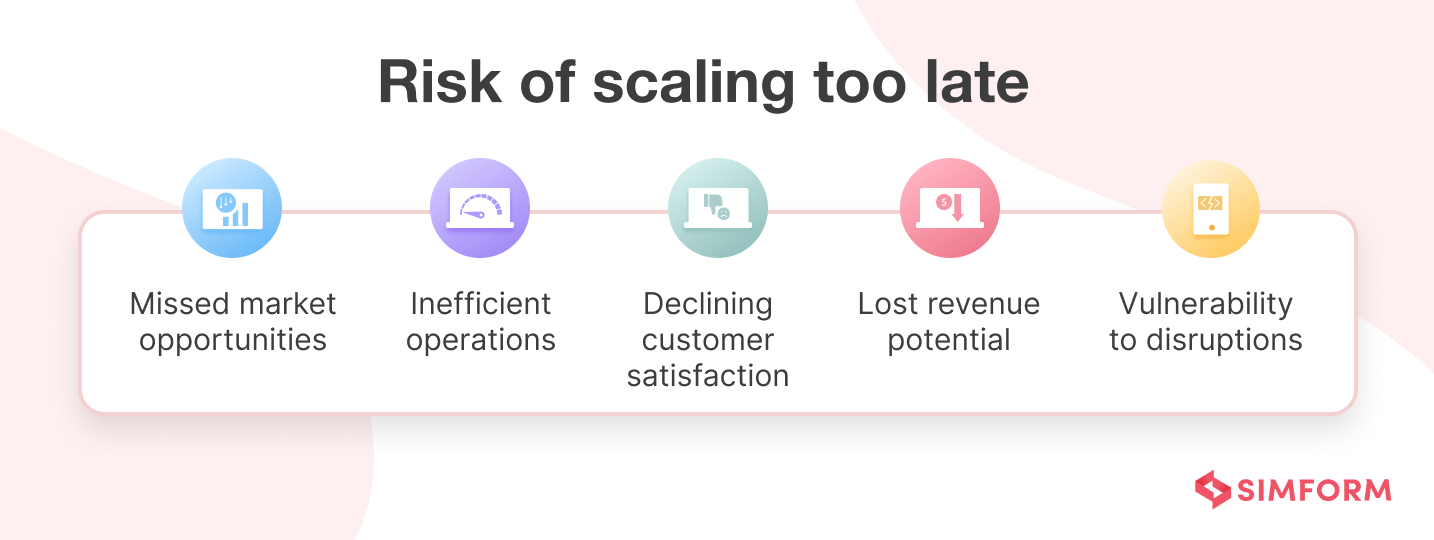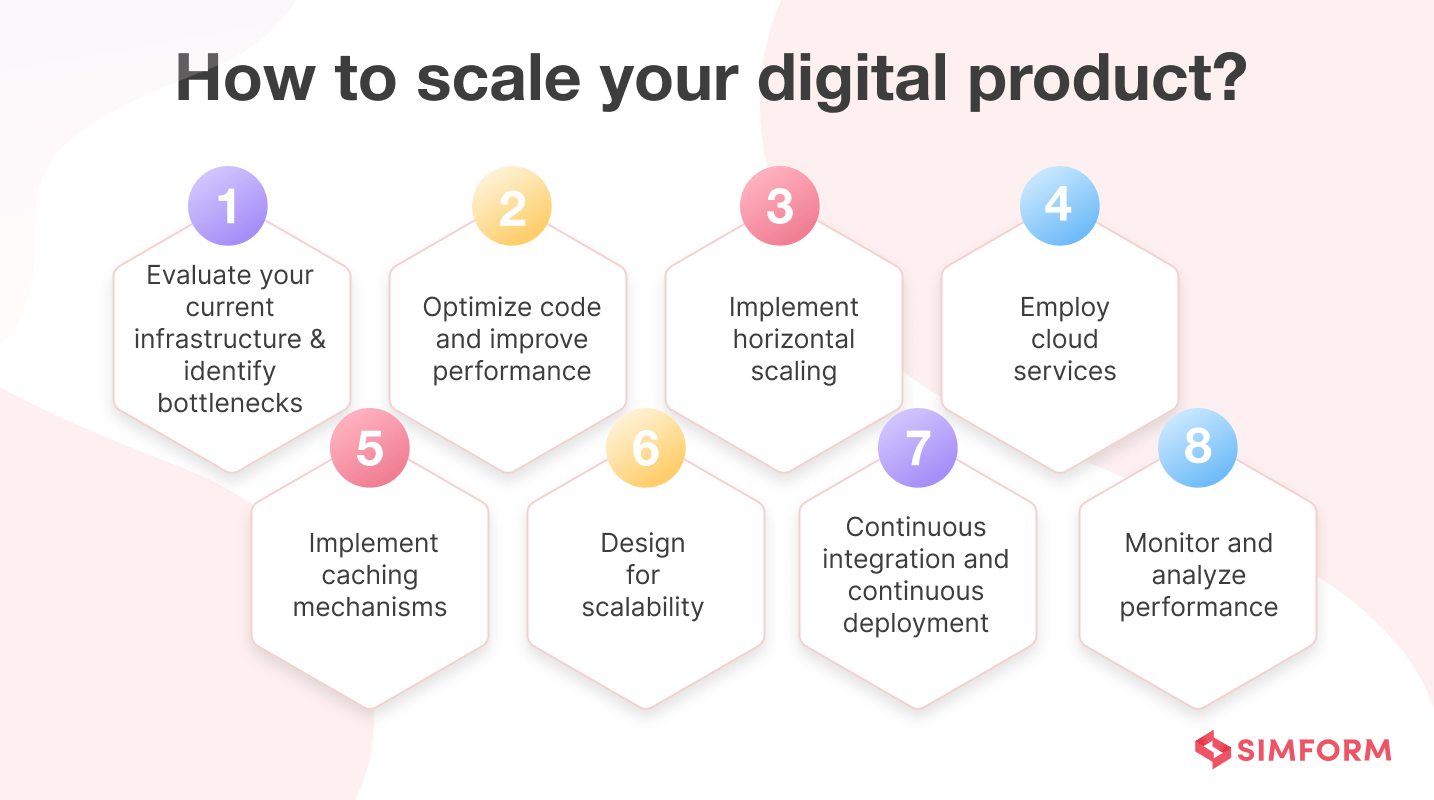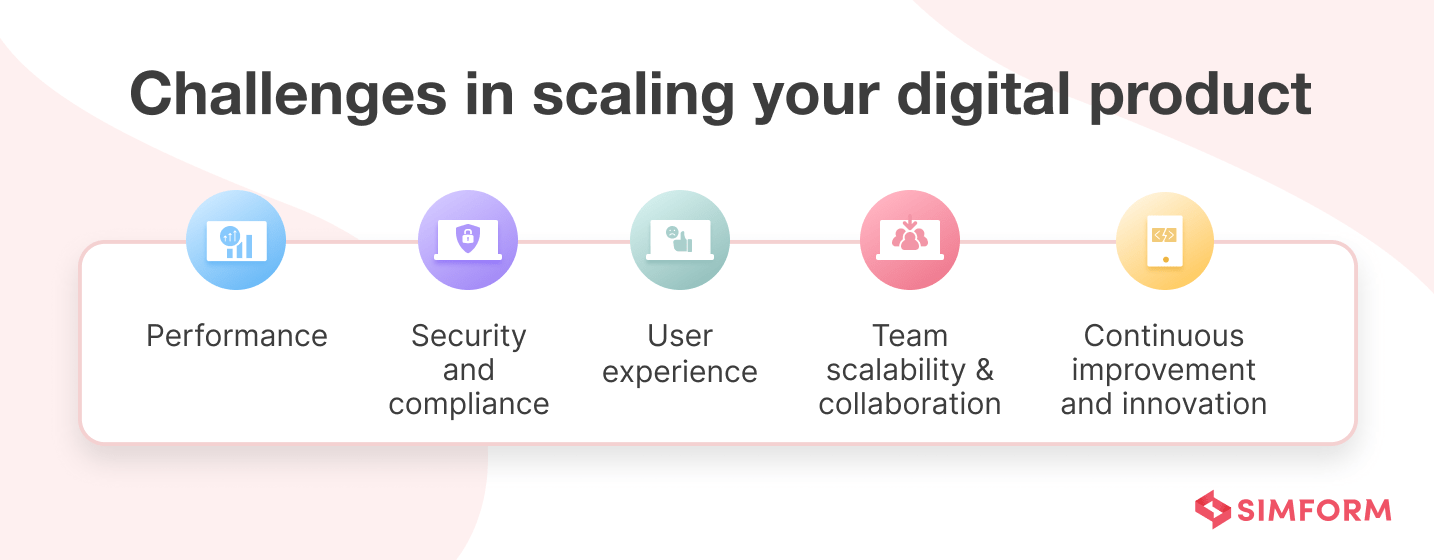FIFA World Cup 2022 was a massive spectacle for football fans worldwide. But when England faced Iran in their opening world cup clash, the BBC iPlayer crashed. Despite being a significant player in the streaming industry, it failed in performance, scalability, and resiliency.
This shows how important scalability is for digital products and what could happen if you don’t have scalable products – your product may not be robust enough to survive and thrive in the market.
Why scale your digital products?
In a nutshell, if you want to grow, meet increasing demands, and stay competitive, you need to scale your product. Here’s more to it:
- Meet growing demand: Horizontal scaling allows you to add more machines or servers to your infrastructure to handle increased traffic and distribute the load. Vertical scaling involves upgrading existing hardware to improve performance and capacity.
- Enhance performance and reliability: By distributing the workload across multiple servers or implementing load balancing techniques, you can reduce latency, handle peak loads efficiently, and ensure a smooth user experience.
- Effective capacity planning: With scalable systems, you can accurately anticipate resource requirements and allocate them accordingly to ensure optimal performance and avoid overprovisioning/underutilizing resources.
When scaling, how do you know, when is the right time?
You know it’s the right time to scale when your business has a consistent demand that your current capacity can’t meet. You have the resources, infrastructure, and systems to support growth effectively.
Slack, for instance, determined the right time to scale its product by monitoring user growth and engagement metrics, database and system performance, and increasing market demand.
Here are the key identifiers from a technical and business perspective that will help you know when it’s the right time to scale your digital product:
Key indicators from a technical perspective
| Technical Indicators | Identifying Factors/Metrics | Relevant Solutions |
| Increased user demand | website/app traffic, server response time, database performance, error rates | use serverless computing, leverage containerization |
| Performance degradation | increasing response times, frequent errors, decreased throughput, high CPU and memory usage | implement parallel processing, upgrade hardware, optimize database or network |
| Database performance issue | slow query execution, increased response times, frequent timeouts, excessive I/O read/write latency, high CPU and memory usage | identify top resource-consuming queries, analyze performance logs, optimize your queries, scale up hardware resources |
| Overwhelming infrastructure utilization | CPU memory, disk space, network traffic, bandwidth consumption | implement resource allocation and prioritization strategies, use load balancing, implement caching, implement database sharding |
| High network traffic | high network latency, slow file transfers, buffering during media streaming, dropped connections | upgrade your network infrastructure, optimize bandwidth allocation, employ Quality of Service (QoS) techniques, implement traffic shaping |
| Increase in data volume | rapidly filling storage systems, increased disk space usage, longer backup and restore times, slower data processing, higher network traffic | scale up your storage capacity, implement data compression, utilize cloud storage, optimize database configurations, employ data deduplication methods |
| Slow integration with third-party services | delayed response times, long processing durations, frequent timeouts, inconsistent data synchronization | optimize API calls, use asynchronous processing, employ load balancing, monitor performance |
Key indicators from a business perspective
| Business Indicators | Identifying Factors/Metrics | Relevant Solutions |
| Revenue growth | increasing sales figures, rising customer demand, higher average transaction value, expanding market share | upgrade your infrastructure, adopt cloud-based systems, optimize your website for increased traffic, leverage automation tools, implement robust data analytics |
| Customer Acquisition Cost (CAC) and Customer Lifetime Value (CLTV) | CAC and CLTV | if CAC is high and CLTV is low, it suggests inefficient customer acquisition. If CAC rises while CLTV remains stable, it indicates a need for optimization. If CLTV exceeds CAC, scaling may be beneficial. |
| High user engagement | increased website traffic, long average session durations, higher click-through rates, a rise in social media interactions, positive customer reviews | A/B testing to optimize user experiences, Microservices architecture for improved performance, Load-testing tools to ensure your system can handle increased user traffic |
| Huge market demand | increasing sales and revenue, high customer demand and inquiries, positive feedback and reviews, growing market size | investing in robust cloud infrastructure, automating processes, expanding your workforce, optimizing the supply chain, improving customer support capabilities |
| Operational efficiency | increased production costs, longer lead times, frequent delays or bottlenecks, high error rates, declining profitability, missed targets or deadlines | use automation |
| Feedback and reviews | feedback pattern mentioning issues like slow response times, long waitlists, or difficulty accessing services, recurring comments about overwhelmed staff or inadequate resources, complaints about limited capacity | implement vertical scaling |
| Team and organizational readiness | robust and scalable processes, sufficient resources and infrastructure, competent leadership capable of managing growth, effective delegation and collaboration, proactive risk management, adaptable and flexible systems , a strong focus on innovation | implementing a phased approach, expanding operations and resources while ensuring alignment, communication, and learning at each stage |
| Expanding geographical reach | Increased demand from different regions, international inquiries, positive customer feedback in new markets | use cloud-based infrastructure and CDNs, leverage localization technologies for adapting your product to different languages and regions |
This is it!
But have you ever wondered what could happen if you scale your products too early or too late?
Risk of scaling too early or too late
Scaling too early can result in:

- Premature resource allocation– leading to wasted resources and financial strain.
- Lack of market demand– leading to overproduction or oversupply, which results in inventory buildup and potential losses.
- Quality and operational issues– impacting quality, customer satisfaction, and brand reputation.
- Financial instability– straining your financial resources and jeopardizing sustainability.
- Inefficient scaling– resulting in inefficiencies, poor internal coordination, and difficulties adapting to changing market dynamics.
Now, if you scale too late, you may have to deal with:

- Missed market opportunities-allowing competitors to gain an advantage.
- Inefficient operations– leading to overwhelmed resources, poor customer experiences, and potential quality issues.
- Declining customer satisfaction- which can result in negative reviews and potential churn.
- Lost revenue potential-hindering profitability and the ability to invest in innovation and expansion.
- Vulnerability to disruptions-making your company less resilient to unexpected disruptions, such as supply chain issues or market fluctuations.
How to scale your digital product?
Well, everyone would say – optimize your infrastructure, leverage cloud services, use caching mechanisms, adopt a microservices architecture, and continuously monitor and optimize performance to effectively handle growing user demand.
How exactly you should do it – is what we have covered here!

Step 1: Evaluate your current infrastructure and identify bottlenecks
To evaluate your current infrastructure and identify bottlenecks, consider factors such as performance, resource utilization, and system dependencies.
Map your process and workflow visually to spot congestion. Assess your system’s responsiveness, throughput, and capacity to handle increasing loads. Analyze resource usage, including CPU, memory, disk, and network, and adjust the distribution to balance the workload and improve the flow. Identify any dependencies or single points of failure that could impact scalability.
To help with this analysis, consider using the following tools:
- Monitoring tools like Prometheus or Nagios can provide real-time insights into system performance, alerting you to potential bottlenecks and resource constraints.
- Profiling tools such as JProfiler or New Relic can help identify performance bottlenecks by analyzing code execution, memory usage, and database queries.
- Load testing tools like Apache JMeter or Gatling can simulate high-traffic scenarios, helping you uncover performance bottlenecks under heavy loads.
Step 2: Optimize code and improve performance
There are several factors you should consider to optimize code and improve performance.
First, analyze your code for bottlenecks or inefficiencies, focusing on algorithms, data structures, and overall design. Secondly, minimize unnecessary computations, memory usage, and disk I/O operations. Finally, consider parallelization and optimizing critical sections of code.
Some common ways of optimizing include–using the right data types, caching frequently used data to avoid repeated calculations, using value stream mapping, adjusting resource distribution, etc.
You may also use tools to optimize code and improve performance, such as:
- Profilers (such as Intel VTune or Java VisualVM) that identify performance bottlenecks.
- Static code analyzers (like SonarQube or PVS-Studio) that help find potential issues and
- Load testing tools (such as Apache JMeter or Gatling) for evaluating performance under various conditions.
Step 3: Implement horizontal scaling
To implement horizontal scaling, you must first design your system to be stateless, as it allows for easier distribution across multiple machines. Next, employ a load balancer to evenly distribute incoming requests among multiple servers. Choose a distributed storage solution to ensure data consistency across the scaled-out system.
Three tools and techniques that aid in horizontal scaling are:
- Containerization platforms like Docker, which allow for easy deployment and scaling of applications;
- Orchestration tools like Kubernetes, which automate the management of containerized applications across a cluster of machines; and
- Auto-scaling features provided by cloud platforms, such as AWS Auto Scaling or Google Cloud Autoscaler, automatically adjust the number of instances based on demand.
Implementing horizontal scaling enables you to build scalable products by improving performance, handling increased user load, and ensuring high availability. It allows your system to handle more requests by adding more servers, resulting in improved responsiveness, reduced downtime, and enhanced user experience.
Note: There are some scenarios when horizontal scaling may not be the correct option. That’s where you may have to consider – vertical scaling. It helps you build scalable products by increasing the resources within a single server or machine.
Here’s when you should implement vertical scaling:
- Your application experiences a sudden increase in traffic or user load.
- You need to quickly address performance issues without making extensive architectural changes.
- Your budget allows for upgrading existing hardware resources.
- Your application’s resource requirements are within the limitations of a single server or machine.
- You prioritize simplicity and ease of management over distributed systems and complex infrastructure.
- The scalability needs of your application are expected to be relatively moderate or predictable.
Step 4: Employ cloud services
To employ cloud services effectively, determine your specific requirements and identify the cloud service provider that aligns with your needs. You may choose from different cloud services such as SaaS, PaaS, and IaaS. Also, choose the cloud model (public, private, hybrid, multi-cloud) for your service.
Next, evaluate the provider’s reliability, security measures, and compliance standards to protect data. Lastly, consider the scalability and flexibility providers offer to accommodate future growth.
In case, if you’re looking to migrate your assets to cloud services, you can use any of these techniques:
- Lift and Shift: You can move your existing applications and infrastructure as they are to the cloud without making significant changes.
- Replatforming: It involves minimal modifications to your applications and infrastructure to optimize them for the cloud environment.
- Refactoring: This technique involves rearchitecting and rewriting your applications to take full advantage of cloud-native features and services.
- Repurchasing: Instead of developing or maintaining your own applications, you can adopt software-as-a-service (SaaS) solutions provided by cloud providers.
- Retiring: Identify and decommission any legacy systems or applications no longer required.
- Retaining: In some cases, keeping certain applications or data on-premises may be beneficial while migrating others to the cloud.
Step 5: Implement caching mechanisms
Start by identifying the data or resources that are frequently accessed or computationally expensive. Then, choose a caching strategy based on data volatility, size, and access patterns.
Three popular caching techniques include:
- In-memory caching: Store frequently accessed data in memory for faster retrieval using tools like Memcached or Redis.
- Content Delivery Networks (CDNs): Cache static content in edge servers geographically distributed to reduce latency and improve content delivery speed.
- Database query caching: Cache the results of frequently executed database queries using tools like Hibernate or QueryCache.
Step 6: Design for scalability
Analyze your system’s expected workload and ensure it can handle increasing demand. Then, design modular components that you can scale horizontally or vertically. Lastly, optimize performance by implementing efficient data management techniques, like caching or sharding.
Here are the techniques and tools that can aid you in scalability design:
- Load balancing: Use tools like Nginx or HAProxy to distribute incoming traffic across multiple servers, preventing overload on any single instance.
- Containerization: Adopt technologies like Docker or Kubernetes to encapsulate your application into containers, facilitating easier deployment and scalability.
- Auto-scaling: Leverage cloud platforms such as AWS Auto Scaling or Google Cloud Autoscaler to adjust resources based on real-time demand, ensuring optimal performance and cost efficiency.
Step 7: Continuous integration and continuous deployment
To achieve continuous integration and continuous deployment, set up a version control system, such as Git, to manage your codebase. Next, automate the build process using tools like Jenkins or Travis CI to compile, test, and package your application. Finally, deploy the built artifacts to production using tools like Docker or Kubernetes.
A few techniques and related tools you should consider using:
- Infrastructure as Code (IaC) using tools like Terraform,
- Continuous Testing with tools like Selenium or JUnit, and
- Canary Releases with tools like Spinnaker or Istio.
Step 8: Monitor and analyze performance
Implement observability. Collect relevant data from various sources such as logs, metrics, and traces. Centralize this data in a unified platform for easy access and analysis. Finally, leverage visualization and analytics tools to gain insights and detect performance issues promptly.
Consider these observability techniques for performance monitoring and analysis:
- Distributed tracing: Use tools like Jaeger or Zipkin to track requests as they traverse a distributed system, enabling you to identify bottlenecks and latency issues.
- Log aggregation: Tools like Elasticsearch, Logstash, and Kibana (ELK stack) help collect and analyze logs from multiple sources, allowing you to detect anomalies and troubleshoot performance problems.
- Metrics monitoring: Tools like Prometheus or Graphite enable you to collect, store, and visualize metrics, providing real-time insights into system performance and resource utilization.
By leveraging observability and following the above steps, you can build scalable products that easily meet customer expectations and scale. However, working through various scaling phases means overcoming obstacles on the path to build a scalable product.
Check how we improved the online web experience for International Hockey Federation (FIH) using React.
Challenges in scaling your digital product (and how to overcome them)
As your product gains popularity and user base, you might probably face these challenges in scaling your digital product:

1. Performance
Scaling your product means increasing the size or complexity of a system that requires more resources and processing power to maintain optimal performance. The increased workload can lead to bottlenecks, slower response times, and decreased efficiency.
To keep peak performance intact while scaling:
- Implement efficient caching mechanisms using in-memory caches like Redis or Memcached.
- Utilize horizontal scaling with containerization (e.g., Docker) and orchestration (e.g., Kubernetes).
- Optimize database performance by indexing frequently accessed data, employing caching strategies, and utilizing database sharding.
- Employ asynchronous processing for time-consuming tasks using message queues (e.g., RabbitMQ or Apache Kafka).
- Utilize content delivery networks (CDNs) to distribute static assets closer to end-users.
2. Security and compliance
As you expand, ensuring data protection, maintaining regulatory compliance, and safeguarding against cyber threats become complex. Managing access controls, encryption, vulnerability testing, and monitoring user activity becomes critical.
To safeguard the product while scaling:
- Implement multi-factor authentication and role-based access control (RBAC).
- Utilize encryption technologies in transit and at rest to protect data integrity and confidentiality.
- Regularly conduct vulnerability assessments and penetration testing to identify and address any security weaknesses.
- Establish comprehensive logging and monitoring systems to detect and respond to security incidents promptly.
- Conduct regular audits and assessments to ensure adherence to GDPR, HIPAA, or PCI-DSS frameworks, depending on the industry and geographic location.
3. User experience
Maintaining a seamless and intuitive experience is critical as you expand your user base. You should balance scalability and usability demands through careful planning, rigorous testing, and ongoing iteration. Lastly, focus on a scale without compromising user experience by adopting a comprehensive approach that addresses technical, design, and operational considerations.
For a consistent user experience:
- Create clear guidelines and best practices for UI/UX design, coding, and testing to maintain consistency
- Design modular and decoupled systems to enable easy expansion and updates without disrupting the user experience.
- Test for usability, functionality, and performance to maintain a reliable user experience
- Solicit regular feedback from users to identify pain points and areas for improvement.
4. Team scalability and collaboration
As the product grows, it requires a larger team with diverse skill sets, making coordination and communication more complex. Effective collaboration requires clear roles and responsibilities, efficient workflows, and streamlined communication channels.
For infusing scaling in the team and maintaining collaboration:
- Implement a distributed version control system like Git to enable seamless collaboration among team members
- Set up a continuous integration and deployment pipeline using tools like Jenkins or CircleCI to automate the build, testing, and deployment processes.
- Utilize containerization technologies like Docker to package the product and its dependencies into portable units.
- Foster a culture of knowledge sharing and documentation by creating internal wikis, code repositories, and regular team meetings.
- Encourage team members to document their work, share insights, and conduct code reviews.
5. Continuous improvement and innovation
As you expand, maintaining the same level of agility becomes difficult. Hierarchies and processes slow down decision-making, hindering innovation. Additionally, customer needs may change, requiring constant adaptation.
To ignite a culture of innovation in harmony with scaling:
- Foster a culture of experimentation by encouraging cross-functional collaboration and providing dedicated resources for innovation projects, such as hackathons and labs.
- Implement scalable architecture and design principles, such as microservices, containerization, and serverless computing.
- Embrace agile methodologies like Scrum or Kanban to enable rapid development and iteration.
- Invest in automation and DevOps practices to streamline the software development lifecycle, improve deployment speed, and ensure consistent quality.
- Encourage knowledge sharing and learning through internal tech talks, mentorship programs, and educational resources.
Simform: Your one-stop destination for scalable and sustainable products
At Simform, we help you:
- Leverage proven techniques like load balancing, caching, and database optimization to enhance your product’s performance and handle increasing user demands.
- With an intuitive UI/UX design, responsive layouts, and efficient frontend/backend architectures.
- A flexible and scalable development team that can adapt to your changing requirements, ensuring rapid project delivery and scaling up or down the team size as needed.
- Enforce robust security measures, including data encryption, access controls, vulnerability assessments, and industry standards compliance to protect your product and user data from potential threats.
- Promote agile development methodologies, continuous integration and deployment, automated testing, and feedback-driven iterations to continuously enhance your product, fix issues, and incorporate user feedback.
Let’s understand how our expertise translates into scalable products with a real-time example. Freewire is a leading EV charging platform. Using Simform’s product engineering expertise, Freewire wanted to build mobile power solutions that meet customers’ growing needs with the least possible downtime while processing millions of data streams.
To ensure fast scalability, we:
- Utilized cloud-native architecture, leveraging platforms like AWS and Kubernetes for efficient resource management and automatic scaling.
- Implemented microservices-based architecture to enhance modularity and scalability.
- Employed containerization with Docker to streamline deployment and scalability.
- Deployed scalable databases like MongoDB and Apache Cassandra to handle increasing data loads.
The outcome? These technologies enabled Freewire to charge 100K+ EVs and reduce downtime by 2x!
Scalability is about embracing the future of your product confidently and taking advantage of it. At Simform, we believe in building scalable, secure, and sustainable products without compromising on performance, reliability, security, or other complex engineering principles.
No matter how you want to scale, we can design, develop, and deploy products that perform well, are secure, and satisfy your customers.